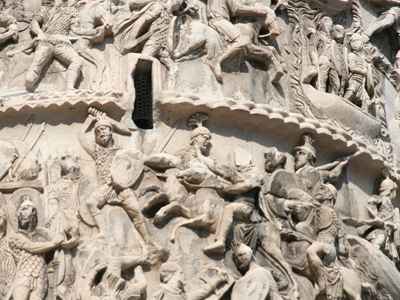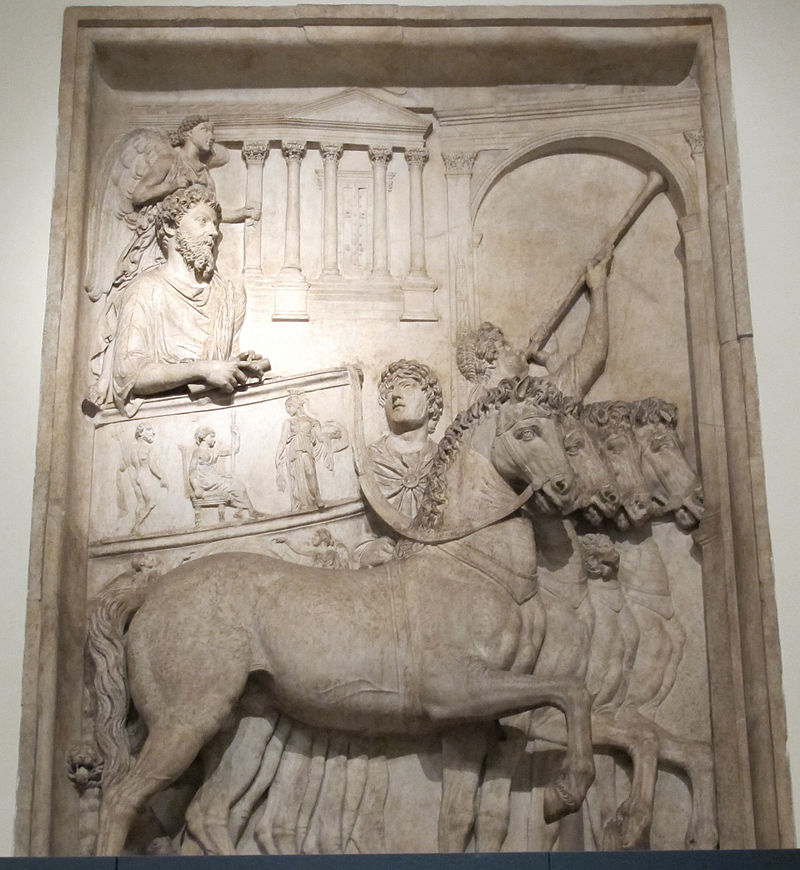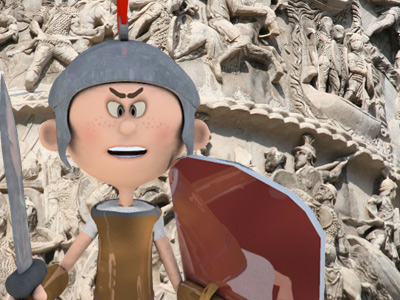Marcomannic Wars (166-180 AD)

First Marcomannic War
First Invasions
Beginning in 162 and continuing until 165, an invasion of Chatti and Chauci in the provinces of Raetia and Germania Superior was repulsed. In late 166 or early 167, a force of 6,000 Langobardi and Lacringi invaded Pannonia. This invasion was defeated by local forces (vexillations of the Legio I Adiutrix commanded by Candidus and the Ala I Ulpia Contariorum commanded by Vindex) with relative ease, but they marked the beginning of what was to come. In their aftermath, the military governor of Pannonia, Marcus Iallius Bassus, initiated negotiations with 11 tribes. In these negotiations, the Marcomannic king Ballomar, a Roman client, acted as a mediator. In the event, a truce was agreed upon and the tribes withdrew from Roman territory, but no permanent agreement was reached. In the same year, Vandals (Astingi and Lacringi) and the Sarmatian Iazyges invaded Dacia, and succeeded in killing its governor, Calpurnius Proculus. To counter them, Legio V Macedonica, a veteran of the Parthian campaign, was moved from Moesia Inferior to Dacia Superior, closer to the enemy.
First Roman Expedition in Pannonia (168)
During that time, as plague was ravaging the Roman Empire The Roman Empire was the post-Republican period of ancient Rome. As a polity, it included large territorial holdings around the Mediterranean Sea in Europe, North Africa, and Western Asia, and was ruled by emperors. The first two centuries of the Roman Empire saw a period of unprecedented stability and prosperity known as the Pax Romana ('Roman Peace'). The Empire was later ruled by multiple emperors who shared control over the Western Roman Empire and the Eastern Roman Empire., Marcus Aurelius was unable to do more, and the punitive expedition he was planning to lead in person was postponed until 168. In the spring of that year, Marcus Aurelius, together with Lucius Verus set forth from Rome, and established their headquarters at Aquileia. The two emperors supervised a reorganization of the defences of Italy and the Illyricum, raised two new legions, Legio II Italica and Legio III Italica, and crossed the Alps into Pannonia. The Marcomanni and the Victuali had crossed the Danube into the province, but, at least according to the Historia Augusta, the approach of the imperial army to Carnuntum was apparently sufficient to persuade them to withdraw and offer assurances of good conduct. The two emperors returned to Aquileia for the winter, but on the way, in January 169, Lucius Verus died. Marcus returned to Rome to oversee his co-emperor's funeral.
The Roman Empire was the post-Republican period of ancient Rome. As a polity, it included large territorial holdings around the Mediterranean Sea in Europe, North Africa, and Western Asia, and was ruled by emperors. The first two centuries of the Roman Empire saw a period of unprecedented stability and prosperity known as the Pax Romana ('Roman Peace'). The Empire was later ruled by multiple emperors who shared control over the Western Roman Empire and the Eastern Roman Empire., Marcus Aurelius was unable to do more, and the punitive expedition he was planning to lead in person was postponed until 168. In the spring of that year, Marcus Aurelius, together with Lucius Verus set forth from Rome, and established their headquarters at Aquileia. The two emperors supervised a reorganization of the defences of Italy and the Illyricum, raised two new legions, Legio II Italica and Legio III Italica, and crossed the Alps into Pannonia. The Marcomanni and the Victuali had crossed the Danube into the province, but, at least according to the Historia Augusta, the approach of the imperial army to Carnuntum was apparently sufficient to persuade them to withdraw and offer assurances of good conduct. The two emperors returned to Aquileia for the winter, but on the way, in January 169, Lucius Verus died. Marcus returned to Rome to oversee his co-emperor's funeral.
Roman Expedition against the Iazyges and the Germanic Invasion of Italy
In the autumn of 169, Marcus set out from Rome, together with his son-in-law Claudius Pompeianus, who would become his closest aide during the war. The Romans had gathered their forces and intended to subdue the independent tribes (especially the Iazyges), who lived between the Danube and the Roman province of Dacia. The Iazyges defeated and killed Claudius Fronto, Roman governor of Lower Moesia. However, while the Roman army was entangled in this campaign, making little headway, several tribes used the opportunity to cross the frontier and raid Roman territory.
To the east, the Costoboci crossed the Danube, ravaged Thrace and descended into the Balkans, reaching Eleusis, near Athens, where they destroyed the temple of the Eleusian Mysteries.
The most important and dangerous invasion, however, was that of the Marcomanni in the west. Their leader, Ballomar, had formed a coalition of Germanic tribes. They crossed the Danube and won a decisive victory over a force of 20,000 Roman soldiers near Carnuntum. Ballomar then led the larger part of his host southwards towards Italy, while the remainder ravaged Noricum. The Marcomanni razed Opitergium (Oderzo) and besieged Aquileia. This was the first time that hostile forces had entered Italy since 101 BC, when Gaius Marius defeated the Cimbri and Teutones. The army of praetorian prefect Furius Victorinus tried to relieve the city, but was defeated and its general slain.
There is no consensus amongst scholars as to the year that the great Gemanic invasion towards Aquileia took place. Several authors, like Marcus Aurelius' biographer Frank McLynn, accepting the date of defeat near Carnuntum as 170, place the great Germanic invasion itself three years earlier. They maintain it happened in 167 because by the year 170 the Germans would have been checked by the Praetentura Italiae et Alpium—the fortifications which were erected in 168–169 to block a breakthrough though the Alps to Northern Italy - whereas all sources confirm it to be a military walkover. A further argument is that the panic which gripped Rome in 167-168 would make no sense if the Germanic tribes were still on the opposite side of the Danube. Also, no source mentions the emperor being near the front when the disaster occurred, whereas by 170 Marcus Aurelius had settled there. McLynn maintains that Marcus Aurelius and Lucius Verus went to Aquileia in 168 to restore morale after the disaster as Aquileia makes no geographical, logistical or military sense as a base of operations for launching a campaign on the Danube in Pannonia. The reason McLynn maintains that 170 is proposed by other authors is that too much weight is given to Lucian's testimony regarding the influence of Alexander of Abonoteichos as a scapegoat for the disaster whereas it is uncertain whether Alexander was still alive by 170 and Lucian's chronology is at certain points suspect.
Deviating from the above discussion in English literature, researchers in Slovenia, one of the regions affected by the Germanic invasion, accept the year 168 as the proper date, based, among other arguments, on a portrait of Lucius Verus found in Ptuj.
The Roman counter-offensive and defeat of the Marcomanni
This disaster forced Marcus to re-evaluate his priorities. Forces from the various frontiers were dispatched against Ballomar. They came under the command of Claudius Pompeianus, with the future emperor Pertinax as one of his lieutenants. A new military command, the praetentura Italiae et Alpium was established to safeguard the roads into Italy, and the Danubian fleet was strengthened. Aquileia was relieved, and by the end of 171, the invaders had been evicted from Roman territory. Intense diplomatic activity followed, as the Romans tried to win over various barbarian tribes in preparation for a crossing of the Danube. A peace treaty was signed with the Quadi and the Iazyges, while the tribes of the Hasdingi Vandals and the Lacringi became Roman allies.
In 172, the Romans crossed the Danube into Marcomannic territory. Although few details are known, the Romans achieved success, subjugating the Marcomanni and their allies, the Varistae or Naristi and the Cotini. This fact is evident from the adoption of the title "Germanicus" by Marcus Aurelius, and the minting of coins with the inscription "Germania capta" ("subjugated Germania"). During this campaign, the chief of the Naristi was killed by the Roman General Marcus Valerius Maximianus.
In 173, the Romans campaigned against the Quadi, who had broken their treaty and assisted their kin, and defeated and subdued them. During this campaign, a famous incident, the so-called "miracle of the rain", occurred, which was later depicted on the column of Marcus Aurelius and on coins. According to Cassius Dio, the legio XII Fulminata was hemmed in by a superior Quadi force and almost forced to surrender because of the heat and thirst. They were saved, however, by a sudden shower, which refreshed the Romans, while lightning struck the Quadi. Contemporaries and historians attributed it to divine intervention: Dio stated that it was called by an Egyptian magician praying to Mercury, while Christian writers such as Tertullian attributed it to a prayer by Christians.
In the same year, Didius Iulianus, the commander of the Rhine frontier, repelled another invasion of the Chatti and the Hermunduri, while the Chauci raided the shoreline of Gallia Belgica.
In the next year, the Romans marched against the Quadi, whereupon the Quadi deposed their pro-Roman king, Furtius, and installed his rival, Ariogaesus, in his place. Marcus Aurelius refused to recognize him, and turning back, deposed and exiled him to Alexandria. Thus, by late 174, the subjugation of the Quadi was complete. In typical Roman fashion, they were forced to surrender hostages and provide auxiliary contingents for the Roman army, while garrisons were installed throughout their territory.

Marcus Aurelius celebrating his triumph over Rome's enemies in 176 AD, riding in a quadriga chariot
After this, the Romans focused their attention on the Iazyges living in the plain of the river Tisza (expeditio sarmatica). After a few victories, in 175, a treaty was signed. According to its terms, the Iazyges King Zanticus delivered 100,000 Roman prisoners and, in addition, provided 8,000 auxiliary cavalrymen, most of whom (5,500) were sent to Britain. Upon this, Marcus assumed the victory title "Sarmaticus".
Marcus Aurelius may have intended to campaign against the remaining tribes, and together with his recent conquests establish two new Roman provinces, Marcomannia and Sarmatia, but whatever his plans, they were cut short by the rebellion of Avidius Cassius in the East.
Marcus Aurelius marched eastwards with his army, accompanied by auxiliary detachments of Marcomanni, Quadi and Naristi under the command of Marcus Valerius Maximianus. After the successful suppression of Cassius' revolt, the emperor returned to Rome for the first time in nearly 8 years. On 23 December 176, together with his son Commodus, he celebrated a joint triumph for his German victories ("de Germanis" and "de Sarmatis"). In commemoration of this, the Aurelian Column was erected, in imitation of Trajan's Column.
HISTORY

RESOURCES
This article uses material from the Wikipedia article "Marcomannic Wars", which is released under the Creative Commons Attribution-Share-Alike License 3.0.
© Stories Preschool. All Rights Reserved.









